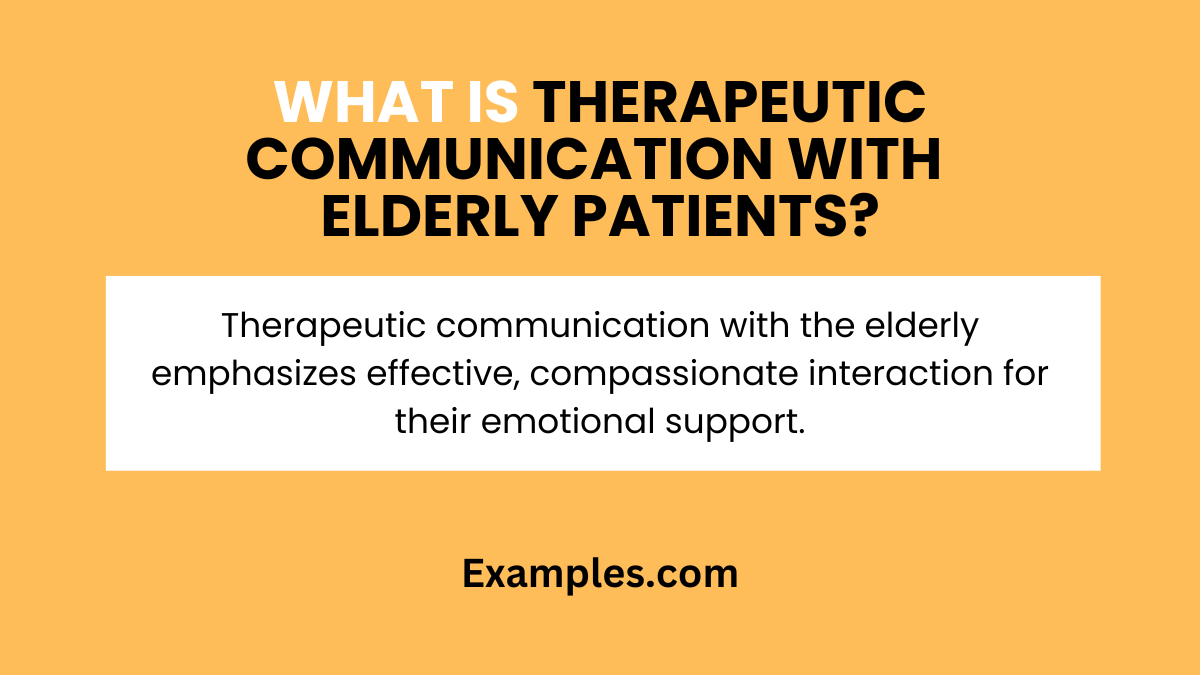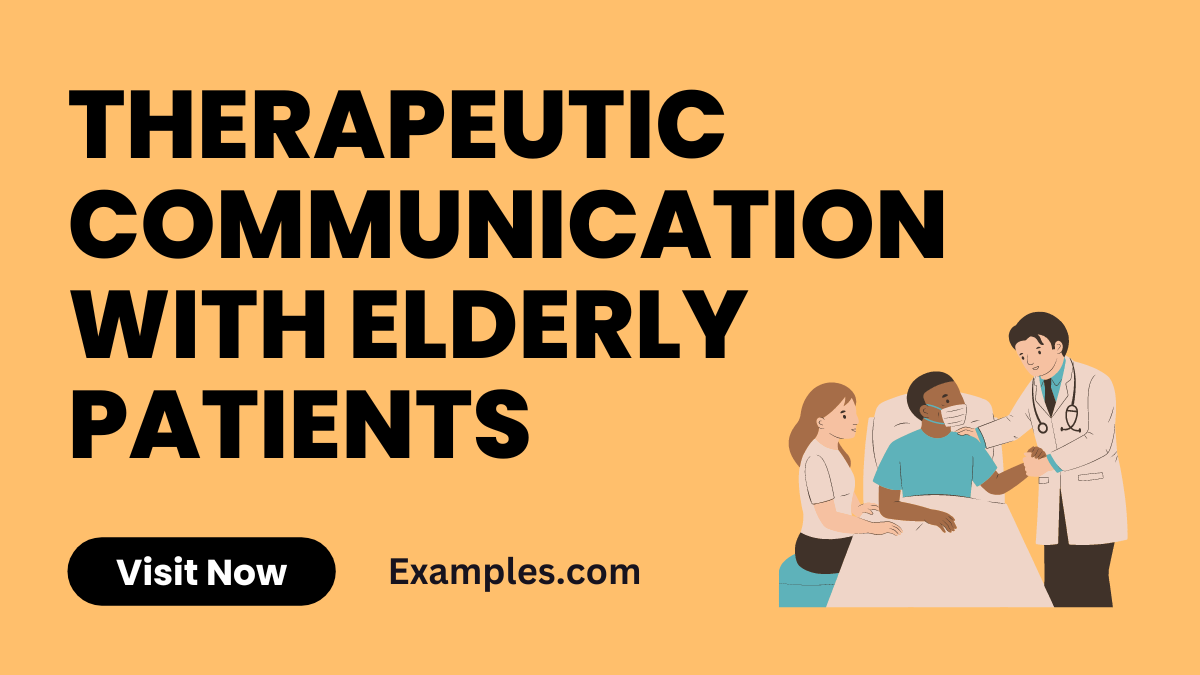14+ Therapeutic Communication with Elderly Patients Examples
In this comprehensive guide, we delve into the art of therapeutic communication with elderly patients. It’s an essential aspect of caregiving that fosters trust, empathy, and meaningful connections. Join us as we explore the definition, uncover the best examples, and provide valuable insights to enhance your ability to engage and support elderly individuals with compassion and clarity.
What is Therapeutic Communication with Elderly Patients?.

Therapeutic communication with elderly patients involves a specialized approach used by healthcare providers and caregivers to interact with older individuals, ensuring their emotional well-being. It prioritizes effective communication skills and interpersonal techniques to create a supportive and compassionate environment.
15 Therapeutic Communication with Elderly Patients Examples
Uncover the nuances of therapeutic communication with elderly patients through 15 illuminating examples. This guide offers practical insights into fostering trust, empathy, and meaningful connections while caring for older individuals. Each example is accompanied by a brief explanation and real-life scenarios, providing valuable lessons on how to communicate effectively, enhance emotional well-being, and create a compassionate caregiving environment.
- Active Listening and Validation: Start by actively listening to the patient’s feelings, validating their emotions, and saying, “I understand you’re feeling anxious, and your concerns are valid.”
- Nonverbal Comfort: Offer a reassuring touch or hold their hand to convey empathy and comfort, like saying, “I’m here to support you” with a gentle touch.
- Using Simple Language: Explain medical procedures or instructions using clear, uncomplicated language to ensure understanding. For example, say, “It’s time for your medication; it will help you feel better.”
- Reminiscing: Encourage reminiscing about fond memories, sparking joy and connection, such as asking, “Tell me about your favorite vacation.”
- Offering Choices: Empower them with choices in their care, like asking, “Would you like tea or coffee?” to provide a sense of control.

- Redirection: Gently guide the conversation to a positive subject when agitation arises, such as shifting to a pleasant memory to ease distress.
- Reassurance: Offer gentle reassurance during moments of confusion, saying, “You’re safe, and I’m here to help” to provide comfort.
- Using Life Story Books: Create a life story book filled with pictures and mementos to trigger meaningful conversations about their history.
- Art and Creativity: Engage in art activities like painting to enhance self-expression and creativity, promoting emotional well-being.
- Validation Therapy: Validate their feelings, even if they seem irrational, with phrases like, “I understand you’re feeling scared, and I’m here to provide support.”
- Sensory Stimulation: Use textured objects or scents to stimulate their senses and create a calming atmosphere.
- Reality Orientation: Gently remind them of the date, time, and location to reduce confusion, saying, “Good morning, it’s Tuesday, and you’re in the hospital.”

- Tailored Communication: Adapt your communication style to their preferences, whether verbal, non-verbal, or written, for better understanding.
- Music Therapy: Play familiar music to trigger memories and reduce anxiety, fostering a positive emotional state.
- Active Engagement: Encourage participation in activities like puzzles to maintain cognitive function and engagement, promoting overall well-being.
Role of Nurse in Therapeutic Communicating with Elderly Patient Examples
Nurses play a pivotal role in ensuring effective therapeutic communication with elderly patients, offering emotional support, and facilitating better healthcare outcomes. Explore these ten unique examples showcasing how nurses can make a difference through empathetic and compassionate communication.
- Active Listening: Nurses actively listen to elderly patients’ concerns, providing comfort and understanding. For instance, nurses listen attentively to a patient’s worries about their upcoming surgery.
- Nonverbal Comfort: Through gentle touch and soothing gestures, nurses convey care and empathy, helping elderly patients feel at ease.
- Clear Explanations: Nurses use simple language to explain medical procedures and treatments, ensuring patients’ understanding. Clear explanations reduce anxiety and confusion.
- Empathetic Responses: Nurses respond empathetically to emotional distress, offering support and reassurance during challenging moments.
- Encouraging Independence: Nurses empower elderly patients by encouraging them to perform daily activities independently, boosting their self-esteem and confidence.
- Customized Communication: Nurses adapt their communication style to suit each patient’s preferences, whether verbal, non-verbal, or written.
- Medication Management: Through patient-centered discussions, nurses ensure elderly patients comprehend medication regimens, increasing compliance.
- Emotional Connection: Nurses build an emotional connection by sharing stories and experiences, creating a bond of trust and understanding.
- Validation and Reassurance: Nurses validate patients’ feelings, offering reassurance in times of confusion or anxiety. Validation and reassurance reduce distress.
- Patient Education: Nurses educate elderly patients about their conditions and encourage them to ask questions. Patient education empowers patients to take an active role in their care.
How do you Therapeutically Communicate Effectively with Elderly Patients?
Effective therapeutic communication with elderly patients is a skill that requires empathy, patience, and adaptability. It plays a crucial role in providing quality healthcare and improving the well-being of older individuals. Below, we explore essential techniques and strategies for achieving effective therapeutic communication with elderly patients.
- Active Listening and Empathy: Begin by actively listening to the patient’s words, emotions, and concerns. Show empathy by acknowledging their feelings and experiences. For instance, say, “I understand that you may be feeling anxious about your treatment.”
- Nonverbal Communication: Nonverbal cues, such as maintaining eye contact, using a warm smile, and employing a gentle touch, can convey empathy and understanding. These gestures enhance the effectiveness of therapeutic communication.
- Clear and Simple Language: Use straightforward and uncomplicated language to ensure that the patient understands the information you are conveying. Complex medical jargon can lead to confusion and anxiety.
- Avoid Rushing: Elderly patients may need extra time to process information and respond. Avoid rushing them and be patient, allowing them to express themselves at their own pace.
- Open-Ended Questions: Encourage conversation by asking open-ended questions that invite the patient to share their thoughts and feelings. This approach promotes engagement and self-expression.
- Respect Personal Space: Be mindful of the patient’s personal space and boundaries. Ensure that you maintain a comfortable and non-threatening physical distance during interactions.
- Reassure and Comfort: Offer gentle reassurance and comfort during moments of distress or confusion. Hold their hand or provide a comforting touch while saying, “You are safe, and we are here to help.”
- Foster Independence: Encourage independence in daily activities whenever possible. Allowing the patient to perform tasks on their own can boost their self-esteem and sense of control.
- Flexibility and Adaptation: Adapt your communication style to the patient’s preferences. Some elderly individuals may prefer written instructions, while others may respond better to verbal communication.
Importance of Therapeutic Communication with Elderly Patients
Therapeutic communication is of paramount importance when interacting with elderly patients for several reasons:
- Emotional Well-being: Effective communication fosters a sense of trust and security, reducing anxiety and emotional distress among elderly patients.
- Enhanced Understanding: Clear and empathetic communication ensures that patients comprehend their medical conditions, treatment options, and care instructions.
- Patient-Centered Care: It promotes patient-centered care, where the patient’s preferences and needs are at the forefront of decision-making, leading to more personalized and effective treatment.
- Improved Compliance: Elderly patients are more likely to adhere to treatment plans and medication regimens when they have a clear understanding and trust in their healthcare providers.
- Enhanced Quality of Life: Therapeutic communication contributes to a better quality of life for elderly patients by addressing their emotional, social, and psychological needs.
Incorporating these techniques and recognizing the importance of therapeutic communication with elderly patients can lead to more meaningful interactions, better healthcare outcomes, and an improved overall patient experience.
Effective therapeutic communication with elderly patients is a vital component of healthcare, fostering trust, empathy, and improved well-being. Through active listening, clear communication, and compassionate care, caregivers and healthcare professionals can enhance the patient experience and ensure better healthcare outcomes for our elderly population. This guide, complete with practical examples and essential tips, empowers individuals to provide elderly patients with the support and understanding they deserve.
In conclusion, mastering therapeutic communication with elderly patients is a crucial skill for healthcare professionals and caregivers. It’s a pathway to building trust, empathy, and meaningful connections with the elderly population, leading to improved healthcare outcomes and a higher quality of life for older individuals. By applying the techniques and tips outlined in this article, you can enhance your ability to communicate effectively and provide the support and understanding that elderly patients need.
For further resources and information on therapeutic communication with elderly patients, consider visiting reputable sources such as the National Institute on Aging and Alzheimer’s Association. These organizations offer valuable insights and guidance on improving communication and care for elderly individuals, adding depth to your understanding of this important topic.



